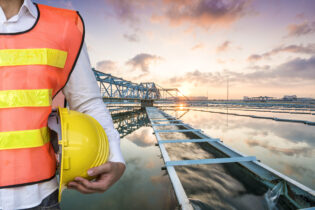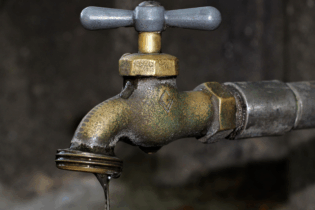Jonathan Julyan studied electrical engineering and made fruit juice for a living but is now sold on the water industry. People ask me how long I’ve been in the water industry,” says electrical engineer Jonathan Julyan. I say: “Thirty-seven years — I’ve got two kidneys, haven’t I?” It’s his stock ice-breaker.
Julyan is project manager for Aveng Water, which, with Optimum Colliery and Mpumalanga’s Hendrina municipality, is celebrating the municipality receiving a Blue Drop award this year, a first for drinking-quality water that includes water reclaimed from acid mine drainage. To receive a Blue Drop award from the Department of Water Affairs a water system must have scored 95% or higher when assessed against the Blue Drop requirements, which look not only at drinking-water quality compliance but also the overall management of the drinking-water system. “The guys (working on the water treatment plant) have worked very hard. We got it first time. It’s brilliant!” Aveng Water has been treating 15000m³ of mine water a day at the colliery since 2010. The water is treated using the company’s unique membrane technology, which provides drinking-quality water to the South African national standard. Drinkable water, although widespread, is not a given in South Africa. Not far from Hendrina, a crisis erupted earlier this year which shows the precariousness of the situation: 17000 people in the Carolina area have had to rely on water tanker deliveries for five months since acid mine water from four mines polluted the town’s water supply. Worse, acid mine drainage has already poisoned water courses in the old gold mining area of the West Rand and threatens the water sources of the Witwatersrand’s central and eastern basins. The Trans-Caledon Tunnel Authority, a state-owned enterprise tasked with sorting out this problem, says it will take R1bn to fix, and that’s just the short-term solution. Aveng Water’s award-winning plant shows that making acid mine water safe for drinking is possible, says Julyan. That can only be good for a water-scarce country (annual rainfall is half the global average) that had already allocated at least 95% of its fresh water by 2005. “Treating acid mine drainage will add to the water available for people and for industry. Pretoria has recently raised its water tariffs by 10%. Water is becoming more and more expensive. The Johannesburg-Pretoria area gets most of its water from Rand Water, which gets its water from the Lesotho Highlands. That’s a good alternative in the short term, but the long term is a problem. We will always have to build more dams and put in more pipes.” Despite the urgency of the problem, there is a tussle between the authorities and mining companies over how South Africa’s acid mine drainage problem should be solved, and who should foot the bill. Environmental activists argue the mining industry should pay for the damage it has caused — a lot of the acid mine water seeping into West Rand watercourses comes from abandoned mines. The industry claims it already has the technology to treat the water, if the government would just pay for it.“People are being reactive while the situation is getting worse. The amount of money the government has set aside is far too little. Just the fact that it is running out — decanting is the correct word — is a problem. It’s all very political … and, let’s be honest, that water contains heavy metals. It will kill you; and not only humans, cattle and plants too.”
Construction on a R24m upgrade got under way this year as part of the government’s “immediate solution” to the West Rand mine water crisis — and South Africa has been told there is less than a year to go before it decants into the region’s central and eastern basins, causing widespread ecological degradation and compromising human and animal health: “I am scared it will be too late — construction on a plant takes two years and there is so much water that needs to be treated.” The Hendrina municipality called in Aveng Water when it was forced to impose constant water restrictions, and buys water from the company. However, the cost — R5 to R7 per cubic metre of treated water — can be offset by the sale of byproducts that come out of the treatment process. “The nice thing is that our two current plants produce gypsum, a by-product that can be used to create partition walls for offices and houses. Anglo has built a couple of full houses from it for their people. It’s very cost-effective, and the insulation properties are very good. The rate at which you can build is very good as well. It’s a wall with a cavity inside. It’s brilliant. You’d swear it was a brick building.” After treatment — through which a nasty brown sludge is transmogrified into clear water — the water is “stabilised” and disinfected with chlorine. Stabilisation is required after reverse osmosis because the process removes minerals from the water. “It tries to remineralise by leeching minerals from infrastructure, so we have to return minerals to the water.” Julyan, who studied electrical engineering at the former Port Elizabeth Technikon, came to Aveng Water via the Western Cape town of Ceres, where he made fruit juices. “That’s all about water. No one takes an orange and squeezes it into a box. About 80% of the juice is water and the rest is concentrate.” But Julyan is sold on the water industry. “Water is a very unique field. I love building something that is lasting. It’s a legacy for the country, and for other countries too. It’s a solution to a problem .” South Africa is home to two of the few acid mine water reclamation plants in the world. Anglo American ’s eMalahleni Water Reclamation Plant won the Asia Mining Global Sustainability Award’s Best Community Project in Africa category earlier this year. Both use Aveng’s Water’s technology, but the eMalahleni municipality did not achieve Blue Drop status. The company is designing two more plants, although Julyan can’t reveal the clients. He says the Aveng technology’s selling point is its ability to reclaim 98% of the polluted water. “It’s South African technology, and we are looking at expanding into the international market. We do have a presence in Australia. It’s extremely exciting to take a field of nothing and build something. Not only can you say you built it, but it is something that is a legacy for the next 20 years. The plants are built to quite high environmental standards, even the concrete we use is specialised. It has specialised coatings to stop the water damaging it. Don’t laugh, but whenever you begin building, you seem to hit the rainy season just as you get started!” Source: Business Day






